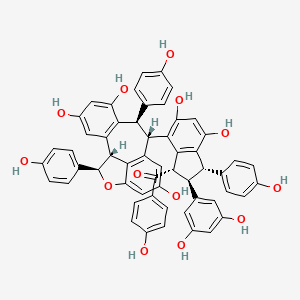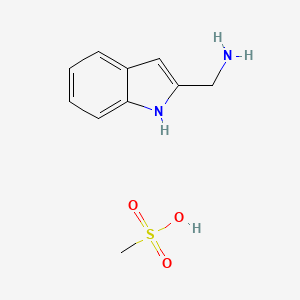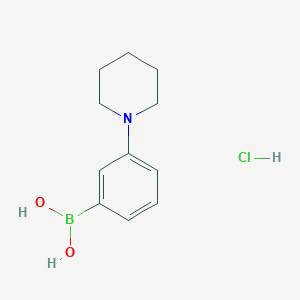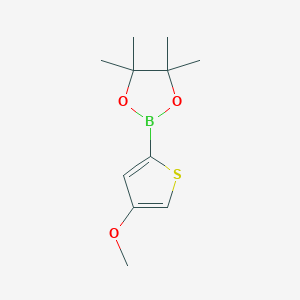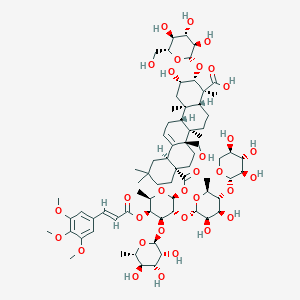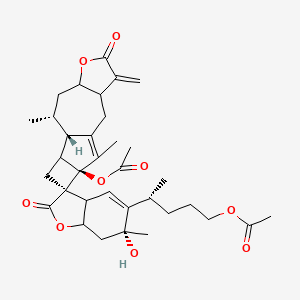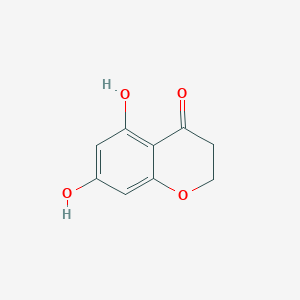![molecular formula C19H20FNO3 B3026791 (3R,4S)-3-[(2H-1,3-BENZODIOXOL-5-YLOXY)METHYL]-4-(4-FLUOROPHENYL)PIPERIDINE CAS No. 112058-85-2](/img/structure/B3026791.png)
(3R,4S)-3-[(2H-1,3-BENZODIOXOL-5-YLOXY)METHYL]-4-(4-FLUOROPHENYL)PIPERIDINE
Übersicht
Beschreibung
Es wird häufig als Antidepressivum verschrieben und hat sich bei der Behandlung verschiedener psychischer Erkrankungen, einschließlich Depressionen und Angststörungen, als wirksam erwiesen .
Herstellungsmethoden
Synthesewege und Reaktionsbedingungen
Die Synthese von Paroxetin-Hemihydrat umfasst mehrere Schritte, ausgehend von der grundlegenden chemischen Struktur von Paroxetin. Der Prozess umfasst die Bildung des Hydrochloridsalzes und die anschließende Kristallisation, um die Hemihydratform zu erhalten. Spezifische Reaktionsbedingungen, wie Temperatur, pH-Wert und Lösungsmittelwahl, sind entscheidend, um die Reinheit und Ausbeute des Endprodukts zu gewährleisten .
Industrielle Produktionsmethoden
Die industrielle Produktion von Paroxetin-Hemihydrat folgt ähnlichen Synthesewegen, jedoch in größerem Maßstab. Der Prozess wird auf Effizienz und Wirtschaftlichkeit optimiert, wobei häufig automatisierte Systeme und strenge Qualitätskontrollmaßnahmen eingesetzt werden, um Konsistenz und Reinheit zu gewährleisten .
Vorbereitungsmethoden
Synthetic Routes and Reaction Conditions
The synthesis of BRL29060A hemihydrate involves multiple steps, starting from the basic chemical structure of paroxetine. The process includes the formation of the hydrochloride salt and subsequent crystallization to obtain the hemihydrate form. Specific reaction conditions, such as temperature, pH, and solvent choice, are crucial to ensure the purity and yield of the final product .
Industrial Production Methods
Industrial production of BRL29060A hemihydrate follows similar synthetic routes but on a larger scale. The process is optimized for efficiency and cost-effectiveness, often involving automated systems and stringent quality control measures to maintain consistency and purity .
Analyse Chemischer Reaktionen
Arten von Reaktionen
Paroxetin-Hemihydrat unterliegt verschiedenen chemischen Reaktionen, darunter:
Oxidation: Beinhaltet die Addition von Sauerstoff oder die Entfernung von Wasserstoff.
Reduktion: Beinhaltet die Addition von Wasserstoff oder die Entfernung von Sauerstoff.
Substitution: Beinhaltet den Austausch eines Atoms oder einer Atomgruppe durch ein anderes
Häufige Reagenzien und Bedingungen
Häufige Reagenzien, die in diesen Reaktionen verwendet werden, umfassen Oxidationsmittel wie Kaliumpermanganat, Reduktionsmittel wie Lithiumaluminiumhydrid und verschiedene Nukleophile für Substitutionsreaktionen. Reaktionsbedingungen wie Temperatur, Lösungsmittel und Katalysatoren spielen eine bedeutende Rolle bei der Bestimmung des Reaktionswegs und der Ausbeute .
Hauptprodukte
Die Hauptprodukte, die aus diesen Reaktionen entstehen, hängen von den verwendeten spezifischen Reagenzien und Bedingungen ab. Beispielsweise kann die Oxidation zu hydroxylierten Derivaten führen, während die Reduktion zu desoxygenierten Verbindungen führen kann .
Wissenschaftliche Forschungsanwendungen
Paroxetin-Hemihydrat hat eine breite Palette wissenschaftlicher Forschungsanwendungen:
Chemie: Wird als Referenzverbindung in analytischen Studien und Methodenentwicklung verwendet.
Biologie: Studiert wegen seiner Auswirkungen auf Neurotransmittersysteme und zelluläre Signalwege.
Industrie: Wird bei der Entwicklung neuer pharmazeutischer Formulierungen und Arzneimittelverabreichungssysteme eingesetzt
Wirkmechanismus
Paroxetin-Hemihydrat übt seine Wirkungen aus, indem es die Wiederaufnahme von Serotonin, einem Neurotransmitter, am präsynaptischen Neuron hemmt. Diese Hemmung erhöht die Konzentration von Serotonin im synaptischen Spalt und verstärkt die serotonerge Neurotransmission. Die Verbindung hemmt auch die Aktivität der G-Protein-gekoppelten Rezeptorkinase 2 (GRK2), was zu ihren therapeutischen Wirkungen beiträgt .
Wissenschaftliche Forschungsanwendungen
BRL29060A hemihydrate has a wide range of scientific research applications:
Chemistry: Used as a reference compound in analytical studies and method development.
Biology: Studied for its effects on neurotransmitter systems and cellular signaling pathways.
Industry: Utilized in the development of new pharmaceutical formulations and drug delivery systems
Wirkmechanismus
BRL29060A hemihydrate exerts its effects by inhibiting the reuptake of serotonin, a neurotransmitter, at the presynaptic neuron. This inhibition increases the concentration of serotonin in the synaptic cleft, enhancing serotonergic neurotransmission. The compound also inhibits G protein-coupled receptor kinase 2 (GRK2) activity, contributing to its therapeutic effects .
Vergleich Mit ähnlichen Verbindungen
Paroxetin-Hemihydrat wird mit anderen selektiven Serotonin-Wiederaufnahmehemmern verglichen, wie zum Beispiel:
- Fluoxetin
- Sertralin
- Citalopram
- Escitalopram
Obwohl all diese Verbindungen einen ähnlichen Wirkmechanismus teilen, ist Paroxetin-Hemihydrat einzigartig in seinen spezifischen inhibitorischen Wirkungen auf GRK2, was zu seinem besonderen therapeutischen Profil beitragen kann .
Eigenschaften
IUPAC Name |
(3R,4S)-3-(1,3-benzodioxol-5-yloxymethyl)-4-(4-fluorophenyl)piperidine | |
|---|---|---|
| Details | Computed by Lexichem TK 2.7.0 (PubChem release 2021.05.07) | |
| Source | PubChem | |
| URL | https://pubchem.ncbi.nlm.nih.gov | |
| Description | Data deposited in or computed by PubChem | |
InChI |
InChI=1S/C19H20FNO3/c20-15-3-1-13(2-4-15)17-7-8-21-10-14(17)11-22-16-5-6-18-19(9-16)24-12-23-18/h1-6,9,14,17,21H,7-8,10-12H2/t14-,17-/m1/s1 | |
| Details | Computed by InChI 1.0.6 (PubChem release 2021.05.07) | |
| Source | PubChem | |
| URL | https://pubchem.ncbi.nlm.nih.gov | |
| Description | Data deposited in or computed by PubChem | |
InChI Key |
AHOUBRCZNHFOSL-RHSMWYFYSA-N | |
| Details | Computed by InChI 1.0.6 (PubChem release 2021.05.07) | |
| Source | PubChem | |
| URL | https://pubchem.ncbi.nlm.nih.gov | |
| Description | Data deposited in or computed by PubChem | |
Canonical SMILES |
C1CNCC(C1C2=CC=C(C=C2)F)COC3=CC4=C(C=C3)OCO4 | |
| Details | Computed by OEChem 2.3.0 (PubChem release 2021.05.07) | |
| Source | PubChem | |
| URL | https://pubchem.ncbi.nlm.nih.gov | |
| Description | Data deposited in or computed by PubChem | |
Isomeric SMILES |
C1CNC[C@@H]([C@H]1C2=CC=C(C=C2)F)COC3=CC4=C(C=C3)OCO4 | |
| Details | Computed by OEChem 2.3.0 (PubChem release 2021.05.07) | |
| Source | PubChem | |
| URL | https://pubchem.ncbi.nlm.nih.gov | |
| Description | Data deposited in or computed by PubChem | |
Molecular Formula |
C19H20FNO3 | |
| Details | Computed by PubChem 2.1 (PubChem release 2021.05.07) | |
| Source | PubChem | |
| URL | https://pubchem.ncbi.nlm.nih.gov | |
| Description | Data deposited in or computed by PubChem | |
DSSTOX Substance ID |
DTXSID90860771 | |
| Record name | (+)-Paroxetine | |
| Source | EPA DSSTox | |
| URL | https://comptox.epa.gov/dashboard/DTXSID90860771 | |
| Description | DSSTox provides a high quality public chemistry resource for supporting improved predictive toxicology. | |
Molecular Weight |
329.4 g/mol | |
| Details | Computed by PubChem 2.1 (PubChem release 2021.05.07) | |
| Source | PubChem | |
| URL | https://pubchem.ncbi.nlm.nih.gov | |
| Description | Data deposited in or computed by PubChem | |
CAS No. |
112058-85-2 | |
| Record name | Paroxetine, (+)- | |
| Source | ChemIDplus | |
| URL | https://pubchem.ncbi.nlm.nih.gov/substance/?source=chemidplus&sourceid=0112058852 | |
| Description | ChemIDplus is a free, web search system that provides access to the structure and nomenclature authority files used for the identification of chemical substances cited in National Library of Medicine (NLM) databases, including the TOXNET system. | |
| Record name | (+)-Paroxetine | |
| Source | EPA DSSTox | |
| URL | https://comptox.epa.gov/dashboard/DTXSID90860771 | |
| Description | DSSTox provides a high quality public chemistry resource for supporting improved predictive toxicology. | |
| Record name | PAROXETINE, (+)- | |
| Source | FDA Global Substance Registration System (GSRS) | |
| URL | https://gsrs.ncats.nih.gov/ginas/app/beta/substances/58SBH37T77 | |
| Description | The FDA Global Substance Registration System (GSRS) enables the efficient and accurate exchange of information on what substances are in regulated products. Instead of relying on names, which vary across regulatory domains, countries, and regions, the GSRS knowledge base makes it possible for substances to be defined by standardized, scientific descriptions. | |
| Explanation | Unless otherwise noted, the contents of the FDA website (www.fda.gov), both text and graphics, are not copyrighted. They are in the public domain and may be republished, reprinted and otherwise used freely by anyone without the need to obtain permission from FDA. Credit to the U.S. Food and Drug Administration as the source is appreciated but not required. | |
Synthesis routes and methods I
Procedure details










Synthesis routes and methods II
Procedure details








Synthesis routes and methods III
Procedure details





Retrosynthesis Analysis
AI-Powered Synthesis Planning: Our tool employs the Template_relevance Pistachio, Template_relevance Bkms_metabolic, Template_relevance Pistachio_ringbreaker, Template_relevance Reaxys, Template_relevance Reaxys_biocatalysis model, leveraging a vast database of chemical reactions to predict feasible synthetic routes.
One-Step Synthesis Focus: Specifically designed for one-step synthesis, it provides concise and direct routes for your target compounds, streamlining the synthesis process.
Accurate Predictions: Utilizing the extensive PISTACHIO, BKMS_METABOLIC, PISTACHIO_RINGBREAKER, REAXYS, REAXYS_BIOCATALYSIS database, our tool offers high-accuracy predictions, reflecting the latest in chemical research and data.
Strategy Settings
| Precursor scoring | Relevance Heuristic |
|---|---|
| Min. plausibility | 0.01 |
| Model | Template_relevance |
| Template Set | Pistachio/Bkms_metabolic/Pistachio_ringbreaker/Reaxys/Reaxys_biocatalysis |
| Top-N result to add to graph | 6 |
Feasible Synthetic Routes
Haftungsausschluss und Informationen zu In-Vitro-Forschungsprodukten
Bitte beachten Sie, dass alle Artikel und Produktinformationen, die auf BenchChem präsentiert werden, ausschließlich zu Informationszwecken bestimmt sind. Die auf BenchChem zum Kauf angebotenen Produkte sind speziell für In-vitro-Studien konzipiert, die außerhalb lebender Organismen durchgeführt werden. In-vitro-Studien, abgeleitet von dem lateinischen Begriff "in Glas", beinhalten Experimente, die in kontrollierten Laborumgebungen unter Verwendung von Zellen oder Geweben durchgeführt werden. Es ist wichtig zu beachten, dass diese Produkte nicht als Arzneimittel oder Medikamente eingestuft sind und keine Zulassung der FDA für die Vorbeugung, Behandlung oder Heilung von medizinischen Zuständen, Beschwerden oder Krankheiten erhalten haben. Wir müssen betonen, dass jede Form der körperlichen Einführung dieser Produkte in Menschen oder Tiere gesetzlich strikt untersagt ist. Es ist unerlässlich, sich an diese Richtlinien zu halten, um die Einhaltung rechtlicher und ethischer Standards in Forschung und Experiment zu gewährleisten.

![2-Thiophenecarboxamide, 5-chloro-N-[(3R,5S)-5-(4-morpholinylcarbonyl)-1-[(1,2,3,4-tetrahydro-2-methyl-6-isoquinolinyl)carbonyl]-3-pyrrolidinyl]-](/img/structure/B3026709.png)
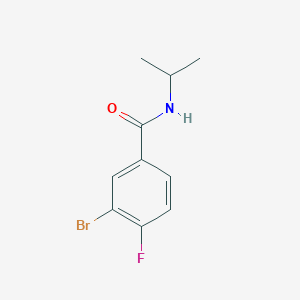
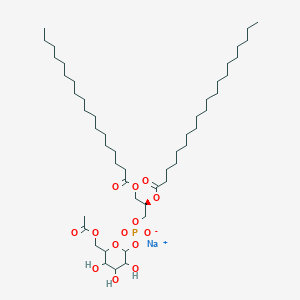
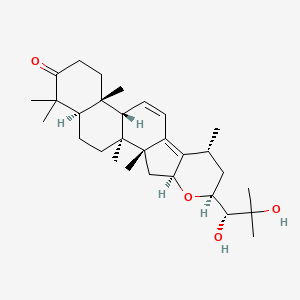
![Kaempferol 3-[2''-(p-coumaroylglucosyl)rhamnoside]](/img/structure/B3026716.png)
